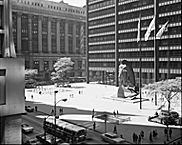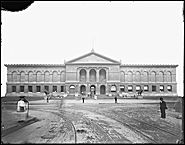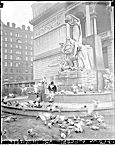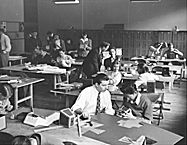| Entries |
| A |
|
Art
|

|
The World's Columbian Exposition, organized in 1893 largely to celebrate Chicago commerce, featured works by Mary Cassatt and other important painters and sculptors. Created especially for the White City, the only permanent building erected for the fair was a Beaux-Arts palace of fine arts centrally located on Michigan Avenue, which following the exposition became the new home of the Art Institute of Chicago (founded in 1866 by a group of artists as the Chicago Academy of Design). The Fine Arts Building, Tree Studios, and many other cultural institutions arose out of the efforts of these patrons and the circle of artists, architects, writers, activists—including Jane Addams, founder of the Hull House —and other creative people to improve the life of the city. These patrons traveled to Europe and brought back Old Master paintings, including El Greco's Assumption of the Virgin, and impressionist and post-impressionist masterpieces—the contemporary art of the day—that eventually formed the Art Institute's collections. Chicago's prestigious social and service clubs, particularly the Union League Club, began collecting art. Institutions such as the Renaissance Society and the Arts Club were founded in the early years of the twentieth century and, in presenting modern art for its own sake, affirmed that art was an important aspect of civilized urban life.

|

|
Chicago art in the 1930s was shaped by the same forces that influenced art elsewhere in the nation, namely the Great Depression and the federally funded Works Progress Administration (WPA). Chicago's brand of social realism differed little from the national norm, influenced as it was by the regional visions of the great muralist Thomas Hart Benton and other social realists. As was typical of the WPA, much art was installed in schools, libraries, post offices, and other public buildings and celebrated the working man and woman, the family, civic life, and the cityscape. Many local artists, including Gertrude Abercrombie, Emil Armin, Eldzier Cortor, Karl Priebe, and Tud Kempf, were employed; the majority of these artists retained a style of social realism, causing their careers to suffer in the 1940s and 1950s.

|
In the immediate postwar era another federal program, the GI Bill, assumed critical significance. Hundreds of returning soldiers who would not have been able to attend college enrolled in art schools, causing a boom in art education which eventually reached a zenith in the 1990s. Veterans such as Leon Golub, George Cohen, and H. C. Westermann brought a more worldly, mature vision to their artistic output, sowing the seeds for the emergence of a unique Chicago school, the Imagists, in the mid-1960s. Many of these artists were profoundly influenced by a 1951 exhibition by French artist Jean Dubuffet (1901–1985) and by his lecture at the Arts Club, “Anticultural Positions,” which stressed the innate creativity of the unschooled individual. Several figures from the prewar scene, however, remained influential and were starting points for later developments. These included Ivan Albright and Gertrude Abercrombie, whose grotesque, detailed figurative style and primitive style, respectively, typify aspects of Chicago art.
Many key patrons, art dealers, and emerging civic and business leaders in the immediate postwar era were University of Chicago alumni who had learned about art and culture directly from artists, many of whom were leaders in the Exhibition Momentum movement. This movement had its genesis when the School of the Art Institute banned student work from its long-standing Annual Exhibitions of Chicago and Vicinity shows in the late 1940s, one of the few places contemporary art was shown in prewar Chicago. Students took matters into their own hands and established a series of highly influential shows, some juried by important New York art world figures, some open to all. Exhibition Momentum artists also set up classes, workshops, and other pedagogical activities for professionals in other fields. These professionals and business leaders, including Joseph Randall Shapiro, Edwin A. Bergman, B. C. Holland, and Richard Gray, exercised major cultural influence in the postwar years.

|
In 1966, also on Chicago's South Side, a style exploded on the scene with the first of three exhibitions at the Hyde Park Art Center by a group who called themselves “The Hairy Who.” These young painters, including Jim Nutt, Gladys Nilsson, and Karl Wirsum, along with other young artists trained by the School of the Art Institute, quickly became collectively known as the Imagists, a term originally coined by critic Franz Schulze to indicate the preceding generation of Chicago artists, now known as the Monster Roster. The Imagists' figurative style, with its emphasis on distortion, precise craftsmanship, garish colors, puns, and word play, came to define Chicago art both within and outside the city. This “Chicago school” received widespread attention, especially after 1973, when the Imagists were featured in the important international exhibition, the XII São Paulo Bienal.

|
Continuing the investigation of the ideas of Negritude pioneered by sculptor Marion Perkins, a veteran of the South Side Community Art Center, a group of artists interested in giving visual expression to the goals of the Black Power movement formed AfriCobra in 1968. Led by Institute of Design–trained Jeff Donaldson, AfriCobra's philosophy of self-determination and social responsibility inspired a national and international network of black teachers and artists still active at the end of the century. School of the Art Institute–trained Richard Hunt became one of Chicago's most successful artists, with over 50 public sculptures placed around Chicago.
The formation of the National Endowment for the Arts as part of President Lyndon Johnson's Great Society programs in the late 1960s enabled an explosive growth of arts institutions. Artist-run spaces such as N.A.M.E. Gallery (1973–1997) especially benefited from federal support, and from this gallery a school of conceptually based art emerged in Chicago concomitant to conceptual art's emergence in New York and Los Angeles. Largely overlooked at the time, this form came to dominate in the 1990s and beyond. Also emerging in the 1970s were groups of time-based artists: video, performance, and experimental film and music were all explored by collaboratives such as the Editing Center, Chicago Filmmakers, and the Experimental Sound Studios as well as by individuals. Dan Sandin, at the University of Illinois Electronic Visualization Laboratory, undertook some of the first investigations in the nation with the video synthesizer and, as computers developed in the 1980s and 1990s, moved on to virtual reality. The Film Center at the School of the Art Institute (founded 1972, now the Gene Siskel Film Center) was built upon foundations laid by dedicated film buffs that dated back to the 1940s and such organizations as the Documentary Film Group at the University of Chicago and the Magick Lantern Society, both founded in the 1960s. The 1970s also saw both the founding and revitalizing of numerous museums to serve a diversified public, including the Balzekas Museum of Lithuanian Culture, the Polish Museum of America, the Spertus Museum of Judaica, The Ukrainian Institute of Modern Art, and the Ukrainian National Museum.
In one of the first such programs in the nation, the Chicago City Council in 1978 unanimously approved a Percent for the Arts ordinance, stipulating that a percentage of the cost of constructing or renovating municipal buildings be set aside for the commission or purchase of art works. Numerous examples of public art soon supplemented the already significant array of public sculpture, many commissioned in the prewar years under the auspices of the Ferguson Fund, an endowment controlled by the trustees of the Art Institute. Chicago's best-known public sculpture, an untitled Picasso in Daley Plaza, however, was a private, much criticized endeavor when it was unveiled in 1967. A 1954 bas-relief by sculptor Milton Horn, Chicago Rising from the Lake, carelessly stored and subsequently discovered and reinstalled in 1998 on Chicago's newly developed Riverwalk (the section of the Chicago River between the lake and roughly LaSalle Street), became a symbol of the strengths and problems of Chicago's impressive public art collection as major reorganization and consolidation of the program took place in the late 1990s.
In the mid-1980s, along with the rest of the nation, Chicago experienced an art boom. The Chicago International Art Exposition, held annually on Navy Pier, brought attention to the vital and growing art community. A greatly expanded gallery scene emerged, with several distinct districts including the West Loop River North area and Milwaukee Avenue. The Art Institute opened a new wing and began regular presentations of contemporary art for the first time in decades, as it continued to mount blockbuster exhibitions of the impressionist and post-impressionist masters so prominent in its collections. The Terra Museum opened on Michigan Avenue in 1987. The Chicago Cultural Center, the State of Illinois Gallery (a branch of the downstate Springfield Illinois State Museum), and the numerous ethnic and university galleries presented exhibitions of local artists at unprecedented rates. Chicago's Mexican American community established the Mexican Fine Arts Center Museum in 1982, with a new facility in 1987. The Randolph Street Gallery (1979–1998) began a new era of socially and politically informed shows curated by teams of artists. Chicago has remained a nexus for controversy around works of art, the most infamous involving a School of the Art Institute student who displayed the American flag on the school gallery's floor.
A fire in April 1989 consumed nearly a dozen major galleries and struck a major blow to the River North gallery district. This disaster, combined with rapidly rising rents as the neighborhood became a dining and entertainment center, has continued the historic process of changing artists' neighborhood and gallery districts, in the 1990s relocating respectively to the near northwest Wicker Park / Bucktown and the near west Fulton Street Market/ University of Illinois neighborhoods. The completion in 1996 of a new and architecturally controversial building by the Museum of Contemporary Art located just off the major North Michigan Avenue shopping district signaled the maturation of the presence of art as a vital force in Chicago, affirming the ideals of Chicago's founders that art is an essential component in a great city.
The Encyclopedia of Chicago © 2004 The Newberry Library. All Rights Reserved. Portions are copyrighted by other institutions and individuals. Additional information on copyright and permissions.